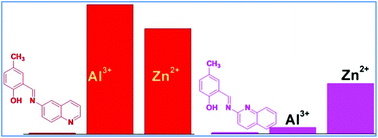Remarkable difference in Al3+ and Zn2+ sensing properties of quinoline based isomers†
Abstract
Two positional isomers, 4-methyl-2-((quinolin-6-ylimino)methyl)phenol (6-QMP) and 4-methyl-2-((quinolin-2-ylimino)methyl)phenol (2-QMP), have been synthesized to compare their fluorescence sensing properties. 6-QMP and 2-QMP have been synthesized by Schiff-base condensation between 2-hydroxy-5-methylbenzaldehyde and the respective amine (6-aminoquinoline for 6-QMP and 2-aminoquinoline for 2-QMP) under mild conditions. These compounds have been characterized by standard methods. 6-QMP and 2-QMP have been found to be dual fluorescence chemosensors for Al3+ and Zn2+ ions but the increment of fluorescence intensity varies. 6-QMP can detect Al3+ (emission at 543 nm) and Zn2+ (emission at 525 nm) by the enhancement of emission intensity by 97 and 79 fold, respectively, with the same excitation wavelength at 415 nm. However, 2-QMP shows two different excitation and emission wavelengths for the detection of Al3+ (emission at 376 nm; λex = 330 nm) and Zn2+ (emission at 550 nm; λex = 435 nm). The increase in emission intensity is low (4.5 fold for Al3+ and 35 fold for Zn2+) compared to that with 6-QMP. The enhancement of intensity may be explained by the PET mechanism. Both the probes form a 1 : 1 complex with both the metal ions as indicated by the elemental and different spectral analysis. 6-QMP shows better sensitivity towards both the metal ions than 2-QMP. Both the probes are able to detect Al3+ and Zn2+ ions by producing distinct color changes that can be observed by the naked eye. Some theoretical calculations have been performed to investigate spectral transitions of the probes along with their aluminum and zinc compounds. These compounds have been used for living cell imaging studies. A comparison with the recently published studies has been made.



 Please wait while we load your content...
Please wait while we load your content...